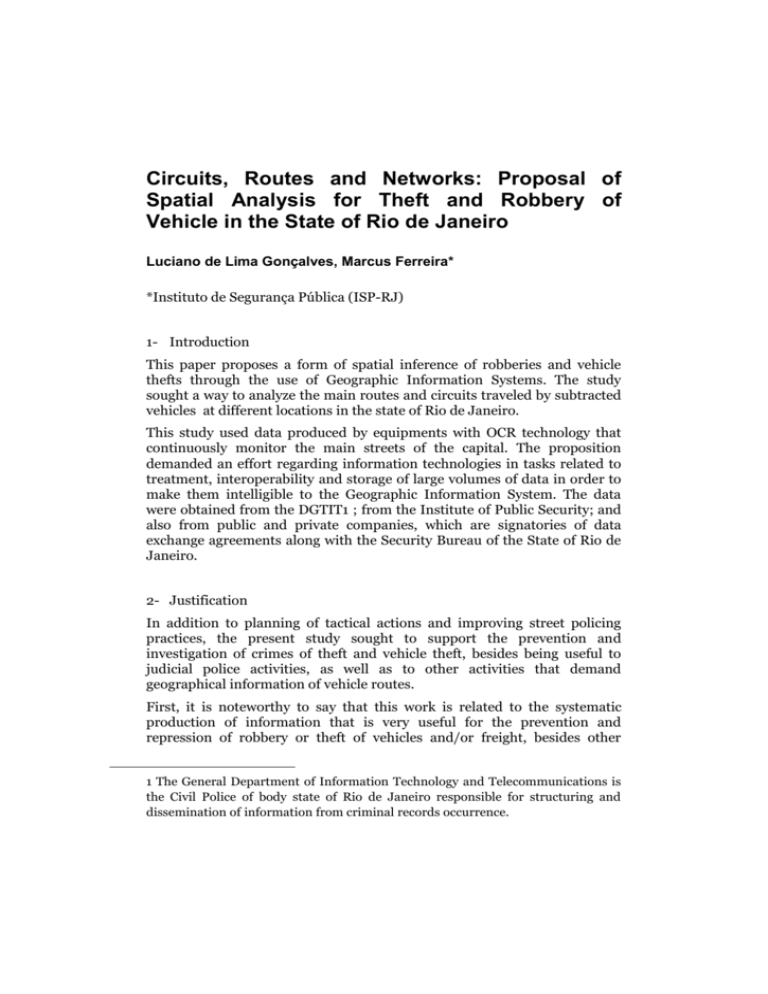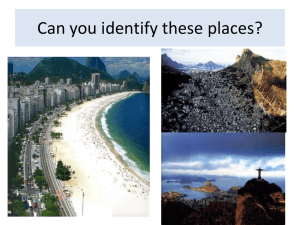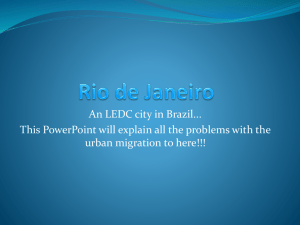Full Text
advertisement

Circuits, Routes and Networks: Proposal of Spatial Analysis for Theft and Robbery of Vehicle in the State of Rio de Janeiro Luciano de Lima Gonçalves, Marcus Ferreira* *Instituto de Segurança Pública (ISP-RJ) 1- Introduction This paper proposes a form of spatial inference of robberies and vehicle thefts through the use of Geographic Information Systems. The study sought a way to analyze the main routes and circuits traveled by subtracted vehicles at different locations in the state of Rio de Janeiro. This study used data produced by equipments with OCR technology that continuously monitor the main streets of the capital. The proposition demanded an effort regarding information technologies in tasks related to treatment, interoperability and storage of large volumes of data in order to make them intelligible to the Geographic Information System. The data were obtained from the DGTIT1 ; from the Institute of Public Security; and also from public and private companies, which are signatories of data exchange agreements along with the Security Bureau of the State of Rio de Janeiro. 2- Justification In addition to planning of tactical actions and improving street policing practices, the present study sought to support the prevention and investigation of crimes of theft and vehicle theft, besides being useful to judicial police activities, as well as to other activities that demand geographical information of vehicle routes. First, it is noteworthy to say that this work is related to the systematic production of information that is very useful for the prevention and repression of robbery or theft of vehicles and/or freight, besides other 1 The General Department of Information Technology and Telecommunications is the Civil Police of body state of Rio de Janeiro responsible for structuring and dissemination of information from criminal records occurrence. offenses directly or indirectly related to the movement of vehicles in public places. From the public safety manager’s point of view, vehicle theft has great relevance not only because there is a large amount of cases in the state of Rio de Janeiro, 32,652 cases recorded in 20142. In addition, we must consider that in each event conditions are created to materialize some form of violence against individuals, in addition to being an important tool for the practice of other crimes. 3- Objectives This proposition involves the structuring, analysis and representation of information in the environment of Geographic Information Systems related to robberies and vehicle theft registered in police stations. The general objective of this work is the transformation of spatial and non-spatial data in geographic information related to subtracted vehicles’ routes. The specific objectives are to know the route of a subtracted vehicle to obtain which circuit would be most frequently used by criminals to recognize certain patterns of movement in different cases. 4- Methods and Techniques 4.1- Data acquisition and processing (structuring) In a GIS environment, spatial and non-spatial data, although conjugated, are treated differently. In this study, the data were treated following the procedures below Treatment of non-spatial data 4.1.1- Treatment of non-spatial data This work's feasibility depended on the compatibility and aggregation of vehicles’ attributes (such as brand, color, year, plate number and chassis number) and on the OCR (Optical Character Recognition) of to the data attributed by police records. The board of the image generated by the "sparrow" is recognized and processed image to a text that is stored with location references, date and time. The municipality of Rio de Janeiro has, in operation, about 400 devices allocated to the main roads making the uninterrupted monitoring of vehicle movement. These data were combined in a new class from which subtracted vehicles3’ (not yet recovered) the routes and circuits were analyzed. 2 Data provided by the ISP - consulted on 29 March 2015 at: www.isp.rj.gov.br. 3 The board of the image generated by the "sparrow" is recognized and processed image to a text that is stored with location references, date and time. The It is important to mention that, this stage requires the validation of more than 100 million monthly records covering all vehicle traffic in the capital of the state of Rio de Janeiro on the main roads, twenty-four hours a day. This requires conversion procedures (interoperability) of data types, demanding a lot of processing and memory capacity. In addition to standardizing the text format of the plates, it is necessary to remove duplicated registers. Only after the depuration of the file, is there the crossing between subtracted vehicles’ data and the ones captured by the equipment. 4.1.2 - treatment of spatial data Spatial data used in this work represent, through arcs, nodes and polygons. The existing elements add feature classes to the topology, hich it was made the spatial analysis: DP districts, OCR vehicle records, criminal activities (robbery and theft) and street vectors. It is noteworthy that, the first results of the analysis are the routes and circuits traveled by the subtracted vehicles. - Police station areas: These are polygons equivalent to the geographic limits of action of district police stations in the state of Rio de Janeiro. There are 138 formally defined areas by the Security Bureau of the State of Rio de Janeiro for all state, such as represented on map 1. municipality of Rio de Janeiro has, in operation, about 400 devices allocated to the main roads making the uninterrupted monitoring of vehicle movement. Map 1: Geographical limits of operation of district police stations in the state of Rio de Janeiro - Structuring of public road vectors (dataset) It consists in structuring the mesh of public roads (map 2), from which one can infer both punctual distribution of records (geocoding) and the estimated routes and circuits, generated after network analysis. Map 2: Vectors of road mesh in the state of Rio de Janeiro - Geocoding OCR plate registers and criminal incidences: Plate records are very simply mapped out, according to the geographical coordinates measured at the time of installation of each equipment. georeferencing criminal activities, however, is done through the process of geocoding addresses found in Police records of robberies, thefts and recovered vehicles. Proceedings regarding geocoding occurrences of robberies, theft and recovery of vehicles were defined after the method proposed by Davis and Fonseca (2007), based on addresses’ attributes listed in each case recorded (PCERJ4)], this is, street name, number of the occurrence’s closest lot, police station division, district and city. This process takes place in two stages: parsing, which consists in a method to identify addresses’ components and arrange them in an appropriate data structure; and matching , which consists in the pairing of the addresses in structured lists (Civil Police micro data), treated during in the previous step. The efficiency of the process depends not only on the cartographic accuracy of the road network and its completeness in relation to existing public roads, but also 4 Civil Police of state of Rio de Janeiro. on the correct completion of the attributes of numbering (initial and final numbers, on both sides) and place names, with due orthographic standardization. Three Rio de Janeiro’s public roads vectors were used: IBGE’s 2010 mesh of roads for the state of Rio de Janeiro the updated mesh the Pereira Passos Institute produced in 2014 for the city of Rio de Janeiro; and the mesh of public roads owned by the Security Bureau of the State of Rio de Janeiro (SESEG). Figure 1: Sequential scheme of geocoding Map 3: instances of theft and vehicle theft in the metropolitan area of Rio de Janeiro between January and to March 2014 5 - Spatial analysis One way to analyze subtracted vehicles’ trajectories is to relate the location of the subtraction with another location where the vehicle has been detected, considering different time intervals between the time of subtraction and a second identification. Through the use of directed graphs and network operators in Geographic Information Systems environment, it is possible to create links between the points of occurrences related to the subtraction of a vehicle by entering prospects of direction, reproducing possible paths through the urban road network. Many of these vehicles are either recovered after being abandoned or are detected by one of the many OCR equipments distributed along the main roads of the capital. In both cases, it is possible to define at least two relative positions, from which a route can be is estimated: the point where crimes occur and the end point of its trajectory the last detected point by the OCR or the vehicle’s recuperation point). This route corresponds to the shortest possible route between two points, given the layout of the mesh of roads. If there are three or more known positions (including the recovery site) where a vehicle has been detected during the time it was in possession of criminals, it is possible to estimate these circuits with greater precision. Besides the arrangement of the estimated route, vertical and horizontal densities have been analyzed, as well as some patterns of dispersion and confluence paths. 5.1- Conformation of routes: As a corollary, parsing yields routes and circuits as a first result. The arc vector expresses a sequence of events corresponding to the movement of a group of vehicles from the subtraction place to the recovery site, or until the last point they were caught by an OCR device. Figure 2: Arcgis screen forming a route Note that in the above example the stolen vehicle trajectory is shaped according to the chronological sequence defined by the date attribute, identified whenever caught by the OCR equipment. Map 4: Vehicle route subtracted in Niterói and detected by OCR equipment in Rio de Janeiro Map 5: Estimated routes based on locations of subtracted vehicles between January and March 2014 in Niterói, São Gonçalo, Marica, Itaboraí and recovered in Rio de Janeiro 5.2- Vertical density: Vertical (or linear) density is the counting of overlapping snippets of routes on each public road segment, from which it was possible to define classes of public road snippets where there is the largest estimated circulation of stolen vehicles. Map 6: Vertical density of road snippets based on subtracted vehicles’ circulation between January and March 2014 in Niterói, São Gonçalo and Itaboraí, and recovered in Rio de Janeiro 5.3 - Horizontal density: Horizontal densities correspond to the areas that portray the of highest distributions of estimated routes, or areas where high capillary movements of stolen vehicles can be found. Map 7 shows the complex case of a sequence of events triggered between late December 2013 and early January 2014 by the dispute between two criminal factions. This case allows us to identify that in the very same area (AISP 9) there is a strong interaction between places with estimated horizontal densities of the theft and vehicle recovery sites. Map 7: Relationship between robbery density and vehicle recovery density in January 2014 6- Conclusion To make our analysis effective with regard to the Police’s tactical actions, planning or investigation, tools that can be easily handled by nonspecialists are necessary. The presentation module defined herein is shown in one or more *.pdf extension files, in which the records related to occurrences during a given period can be found by means of textual and individualized searching, portraying both the shapes represented in different layers on the map and the contents in tables. The GeoPDF technology allows the average user (non-specialist) to represent, access and analyze spatial data produced in Geographic Information Systems environment. The presentation tool allows two basic forms of data recovery: 6.1 - Access to alphanumeric data As a product of the analysis performed in the GIS, the GeoPDF files contain small databases, showing records of several important feature classes for the analysis of criminal activities related to robbery and theft. In this study, the number of records cannot exceed much the average sum of monthly registers of theft and vehicle theft (about 4,500 in Rio de Janeiro). Thus, it was established a limit of 5,000 records, which include data from different classes: theft offenses; routes; densities of occurrences of robbery and theft; and police stations. This means that the analysis, as a rule, is restricted to an area or cover a specific period. Figure 2 shows a simple search for plate number, the result being is a list of features that contains this reference. Figure 2: Textual search in GeoPDF 6.2 - Access to map features In addition to textual search , information retrieval can be performed directly from the map by means of object selection (route, occurrence of vehicle theft, theft, recovery or any other existing feature on the map), which can be analyzed individually. The GeoPDF has measuring tools, from which it is possible to identify coordinates, measure the area of the polygons and the distance from the map. Figure 3 shows the result of a search which displays the occurrence point of the theft and the content of its record generated at the police station, plus the vehicle's characteristics. Figure 3: individualization of occurrence registers in GeoPDF Although the preliminary results presented here expressed, in spatial perspective, an ermerging criminal reality and pointed out numerous possibilities of analysis that could be proposed for specific activities in different aspects of public safety. Its use as a tool, however, will depend on the appreciation of space as a fundamental aspect of criminal practice. 7- References BAIR, S.; BOBA, R.; FRITZ, N.; HELMS, D.; & HICKS, S. Advanced Crime Mapping Topics. Denver University, 2002. Disponível em:<http://www.iaca.net/articles/advancedcrimemappig.pdf>. Acessado em: 12/12/08. LOCAL? DANTAS, G. F. de l. & SOUZA, N. G. de. As Bases Introdutórias da Análise Criminal na Inteligência Policial. São Paulo: Instituto Brasileiro de Ciências Criminais (IBCCRIM), 2004. DAVIS JR., C.A., FONSECA, F. & BORGES, K.A.V. A Flexible Addressing System for Approximate Urban Geocoding. In: SIMPÓSIO BRASILEIRO DE GEOINFORMÁTICA, 5., 2003, Campos do Jordão. CD-ROM. Campos do Jordão: INPE, 2003. FERREIRA, M. & CAMPAGNAC, V. Ferramentas de Monitoramento e Análise de Padrões Regionais. In: CONGRESSO DE GESTÃO PÚBLICA, 6., 2013. Anais. Brasília: CONSAD, 2013 FERRO JUNIOR, C. M. Inteligência Organizacional, Análise de Vínculos e Investigação Criminal: Um Estudo de Caso na Polícia Civil do Distrito Federal. 2007. 138f. Dissertação (Mestrado em Gestão do Conhecimento e da Tecnologia da Informação). Universidade Católica de Brasília, Brasília, 2007. HARRIES, K. Mapping Crime: Principle and Practice. Washington,D.C: U.S. Department of Justice, 1999. Disponível em: <www.ncjrs.org/html/nij/mapping/pdf.html>. Acessado em: 13/12/2008. HYMANN, H. Planejamento e Análise da Pesquisa: Princípios, Casos e Processos. Rio de Janeiro: Lidador, 1967. SAMPSON, R. & SCOTT, M.S. Tackling Crime and Other Public Safety Problems: Case Studies in Problem-Solving. Washington, D.C.: U.S. Department of Justice, Office of Community Oriented Policing Services, 2000. SANTOS, M. O espaço: Sistemas de Objetos, Sistemas de Ação. In: SANTOS, M. A Natureza do Espaço: Técnica e Tempo, Razão e Emoção. 4. ed. São Paulo: EDUSP, 2006.







